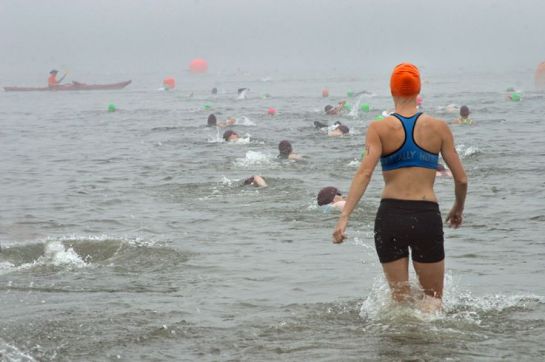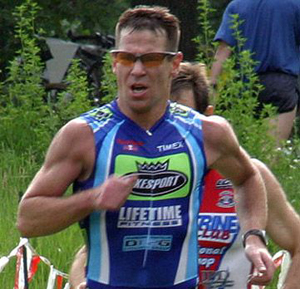By Tom Demerly for tomdemerly.com.

Three participants died in the swim leg of two different triathlons within seven days in Wisconsin this June. It’s an ominous start to the 2019 Midwest triathlon race season, raising questions about athlete safety, fitness and medical screening prior to participation in long distance triathlons such as Ironman and even shorter distance beginner events, where one of this month’s swim fatalities occurred.
Todd Mahoney, 38, and Michael McCulloch, 61, died during the 1.2-mile open water swim of the Ironman 70.3 Wisconsin, Madison triathlon on Sunday, June 9. The race is commonly referred to as a “half-Ironman” for its total distance of 70.3 miles. The event is half the total distance of a “full-Ironman” or 140.6-mile combined swim/bike/run distance event. The week before on Sunday, June 2, 59-year old Scott Beatse died in the Lake Mills Triathlon, also in Wisconsin. The Lake Mills Triathlon was a short-distance triathlon with a 400-meter (1/4 mile) swim, 16-mile bike and 3.1 mile run. The specific cause of death for each participant has not been released.
A September, 2017 report on triathlon swim deaths published in Reuters Health News by journalist Lisa Rapaport revealed that, “A study of more than 9 million participants over three decades found that deaths and cardiac arrests struck 1.74 out of every 100,000 competitors.”

While Rapaport’s story makes the chances of dying in a triathlon swim seem low, the 30-year duration of the study and the method of data collection may miss some key changes in current triathlon demographics. During the last decade, triathlon events have “filled from the bottom” with most participants coming from the beginner demographic. Beginner participants may- or may not– have adequate fitness or pre-existing medical conditions that go undetected until they experience the physical and mental stress of triathlon participation.
The question of whether athletes should be required to have mandatory pre-race medical screenings has been an unpopular one in U.S. triathlon events. In general, race organizers and participants are opposed to the idea of mandatory medical screenings prior to participation. But in endurance events outside the U.S. like the 156-mile Marathon des Sables, an ultra-distance running stage race in the Sahara Desert, all citizen-participants are required to have a cardiac EKG and basic medical health check certified by a medical doctor in their home country prior to entry. In the professional Tour de France bicycle race, cyclists receive a comprehensive medical exam prior to participation not only to screen for performance enhancing drugs, but also to detect any pre-existing conditions that may pose a health risk during the race. In the long distance Raid Gauloises adventure race, pre-race medical checks were also required.
There are reasons to question the effectiveness of pre-event medical screening in reducing fatalities among recreational participants. Basic pre-race medical exams such as an electro-cardiogram, blood pressure measurement and medical history may not reveal common athlete killers such as a “Patent Foramen Ovale” or PFO. The PFO, a cardiac defect, is present in “about 25 percent in the general population” according to the American Heart Association. A PFO can result in a cryptogenic stroke, which can be fatal, especially if suffered during an open water swim where even a mild PFO-induced stroke can lead to disorientation that may contribute to drowning.
PFOs are difficult to detect in a routine medical examination. They commonly require a color flow Doppler echocardiogram or transthoracic echocardiographic (TTE) imaging test to detect. These tests are not routine in general medical examinations and usually only administered after a patient has suffered a stroke as a diagnostic tool to discover the cause of the stroke. PFOs can be treated with a small cardiac implant to prevent their return.
Other factors that could contribute to athlete mortality and medical risk include participating in triathlons while being overweight. As special categories for participants categorized by weight have been introduced in triathlons, called “Clydesdale” and “Athena” categories, there may be more overweight participants in triathlons. While there appear to be no published metrics on risk factors for overweight participants compared to non-overweight participants in triathlons, overwhelming exercise research verifies that being overweight is a general health risk. It’s unlikely, however, that any endurance event would begin excluding participants based on health-based risk factors such as weight or family medical history.
Similar, documented risk factors exist for older athletes. As the general demographic of triathlon participations is likely growing older, common age-related health risks are increasing in the general triathlon population. Although participating in triathlons at older ages presents additional risk commonly associated with general aging, older participants are often celebrated as exceptional in triathlon. In fact, regular, moderate aerobic exercise- although usually less strenuous than triathlon distances and not in a competitive setting- have been commonly cited as beneficial to reducing age-induced health risks, especially obesity, in many credible medical findings. While risks for aging endurance athletes remain and even increase, the benefits may be worth it when spread across the broader population if participation is approached with moderation and medical monitoring.
Ultimately it is difficult to make a case for any one set of common medical diagnosis to predict athlete risk factors in triathlons except for obesity and aging. It is common knowledge that overweight athletes are at greater risk than non-overweight athletes. Those risk factors themselves are part of the reasons overweight people begin to exercise- to moderate the health risks of obesity by losing weight through exercise and diet. It’s also common knowledge that older people have more health risks than younger people. It doesn’t require a medical screening to reveal any of those realities.
Perhaps the greater question is why participants who know they have risk factors would participate in triathlons when a more moderate approach to managing risk factors such as weight loss may be safer? This is especially true for long-distance triathlons. Using less strenuous exercise as managed by a health care provider over time to moderate risk factors such as obesity before participating in triathlons makes sense. This approach addresses the risks faced by participants with conspicuous pre-existing exercise risks like age and being overweight. It does nothing to predict the mortality of participants with difficult to detect medical problems like PFOs. Unfortunately, as the triathlon community has learned so far in 2019, these may be undetectable killers.
 Author Tom Demerly has competed in well over a hundred triathlons including the Ironman Triathlon World Championship in Kona, Hawaii and five other Ironman triathlons around the world. He is a four-time state cycling champion and has participated in endurance events on all seven continents including the Marathon des Sables, the Eco-Challenge and the Raid Gauloises. He has also climbed the highest mountains on three continents and the highest mountain in the western hemisphere. Demerly is a stroke survivor who suffered a stroke while running in October, 2006 from a Patent Foramen Ovale. He had heart surgery to correct a cardiac birth defect that caused the stroke. He was also a member of an elite Army National Guard Long Range Surveillance Unit (LRSU), Co. “F”, 425th INF. (AIRBORNE), Michigan National Guard.
Author Tom Demerly has competed in well over a hundred triathlons including the Ironman Triathlon World Championship in Kona, Hawaii and five other Ironman triathlons around the world. He is a four-time state cycling champion and has participated in endurance events on all seven continents including the Marathon des Sables, the Eco-Challenge and the Raid Gauloises. He has also climbed the highest mountains on three continents and the highest mountain in the western hemisphere. Demerly is a stroke survivor who suffered a stroke while running in October, 2006 from a Patent Foramen Ovale. He had heart surgery to correct a cardiac birth defect that caused the stroke. He was also a member of an elite Army National Guard Long Range Surveillance Unit (LRSU), Co. “F”, 425th INF. (AIRBORNE), Michigan National Guard.






